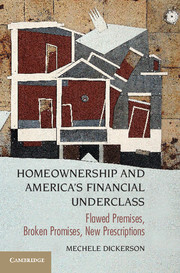 Homeownership and America's Financial Underclass
Homeownership and America's Financial Underclass Book contents
- Frontmatter
- Dedication
- Contents
- Acknowledgments
- 1 Chasing the American Dream
- 2 The Happy Homeownership Narrative
- 3 U.S. Support for Homeowners
- 4 The Homeownership Crisis
- 5 Homeowner Harm and the Blame Game
- 6 Flawed Premises
- 7 The Burden of Home Buying While Black or Latino
- 8 The Benefits of Home Buying While Black or Latino
- 9 Homeownership: Educational Disparities
- 10 Homeownership: Income Disparities
- 11 Outlook and Prescription for the Future
- Index
- References
10 - Homeownership: Income Disparities
Published online by Cambridge University Press: 05 July 2014
- Frontmatter
- Dedication
- Contents
- Acknowledgments
- 1 Chasing the American Dream
- 2 The Happy Homeownership Narrative
- 3 U.S. Support for Homeowners
- 4 The Homeownership Crisis
- 5 Homeowner Harm and the Blame Game
- 6 Flawed Premises
- 7 The Burden of Home Buying While Black or Latino
- 8 The Benefits of Home Buying While Black or Latino
- 9 Homeownership: Educational Disparities
- 10 Homeownership: Income Disparities
- 11 Outlook and Prescription for the Future
- Index
- References
Summary
Homeowners in the Narrative need steady employment to be able to save money for a 20 percent down payment. The hypothetical homeowner also needs steady income to qualify for a low-cost mortgage and to then repay the loan over fifteen to thirty years. Chapter 9 shows why black, Latino, and LMI Americans enter the workforce less educated and with higher debt loads. Because K–12 and college sorting puts them at a disadvantage in labor markets, black, Latino, and LMI workers have higher unemployment rates and lower credit scores, income, and wealth than white and upper-income workers. These disparities make it harder for them to buy homes, and until the income and wealth gaps close, they will never reap the Narrative’s homeownership benefits.
EMPLOYMENT
Even though state and federal laws protect employees from overt discrimination in the workforce, recent charges filed with the United States Equal Employment Opportunity Commission (EEOC) and suits that the EEOC has filed against employers expose the employment discrimination that blacks and Latinos – particularly black males – continue to face in U.S. labor markets. For example, the number of charges employees filed with the EEOC in the last decade has ranged from a low of approximately 26,000 in 2005 to more than 35,000 a year in both 2010 and 2011. Despite these somber numbers and ongoing discriminatory practices in the workforce, employment conditions for black and Latino workers have improved, and employers are less likely to engage in the blatantly discriminatory practices that were commonplace until the 1970s. However, studies show that implicit or explicit negative biases that employers have against black and Latino workers continue to make it harder for blacks and Latinos to succeed in labor markets.
- Type
- Chapter
- Information
- Homeownership and America's Financial UnderclassFlawed Premises, Broken Promises, New Prescriptions, pp. 231 - 251Publisher: Cambridge University PressPrint publication year: 2014


